Why Always-On Influencer Marketing is So Effective for Brands
Adopting an always-on influencer marketing strategy is key to better campaign ROI. This post explains why influencer campaigns shouldn’t be one-hit...
If you need influencer campaign inspiration, this post has you covered! Below we highlight eight awesome micro-influencer marketing campaigns in action.
%20(1).jpg)
%20(1).jpg?width=800&height=450&name=Campaign%20examples%20cover%20(compressed)%20(1).jpg)
You don’t have to look hard to find examples of influencer marketing campaigns.
Thing is, micro-influencer campaigns can be tough to spot because they feel organic.
And that’s exactly the point!
So many brands rely on micro-influencers and we totally understand why. We've seen firsthand how small creators can drive higher engagement rates and powerful social proof at scale.
But what does a “good” influencer marketing campaign look like in the wild, though?
Good question! We compiled eight micro-influencer campaign examples from totally different industries to inspire you. These examples show how influencers benefit brands of all shapes and sizes.
Skip to Section 👇8 Micro-Influencer Marketing Campaign Examples to Inspire Your Brand What Do the Best Influencer Marketing Campaigns Have in Common? |
Food for thought: 84% of consumers purchase a product based on a creator’s recommendation. The power of influencers is crystal clear for brands today.
A big benefit of influencer marketing is that campaigns can accomplish multiple goals simultaneously.
Want to brand build awareness and a library UGC? You totally can!
Our take: brands need all of the influencer campaign inspiration they can get.
Especially given how quickly trends evolve and as creators find new ways to promote products. The micro-influencer marketing examples below reflect brands crushing a variety of goals.
And with that, let's dive in.
Real content can really impact your bottom line. That’s where influencers come in.
Consider how needless returns and poor reviews plague so many fashion brands. When fits don’t meet expectations, consumers are understandably disappointed.
Picture-perfect product shots and photoshopped models are the norm. We get it.
But in-house creatives don’t always reflect exactly what customers are getting.
As a result, fashion brands turn to creators to show off what their fits look like on everyday consumers. This also explains the popularity of the “What I Bought vs. What I Got” trend on TikTok.
Brands like Aerie have made authenticity a cornerstone of their marketing strategy with the help of influencer content. The brand’s recent Mother’s Day campaign featured unfiltered creator content.
In these “fit checks,” creators introduced themselves and their mothers wearing Aerie’s products.

Source: @aerie
The Reel above is a textbook example of genuine content at work. Not sales-y at all. The mother-daughter angle also creates a sense of realness and relatability. Not to mention making it easier for shoppers to imagine themselves in Aerie’s fits.
This is one of our favorite micro-influencer marketing campaign examples because it’s so simple yet so effective. The post's engagement and positive comments reflect the power of real content from real people.
Authenticity matters. Consumers resonate with content that features people they can relate to. The more your influencers reflect your target audience, the better. Keeping it real with your followers via genuine influencers can do the trick.
Competition among beauty brands is fiercer than ever on social media.
And so the more content and social proof you can earn, the better.
Standing out in the beauty and skincare spaces is a numbers game. Content at scale is key to getting your audience’s attention in such a crowded space.
This is another example of how micro-influencer campaigns can pick up the slack and build a foundation of branded content. Many beauty brands are turning to TikTok to do just that. The platform’s audience is eager for product recs and creative videos alike.
Look no further than Luseta Beauty for inspiration on how to leverage influencers. The brand turned to TikTokers to hype up their Biotin and Collagen collections. A single creator’s post earned a whopping 1.8 million views and 300,000 likes.
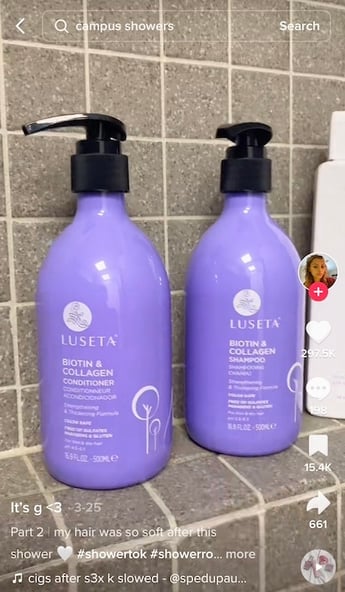
.jpg?width=340&height=595&name=Luseta%20Beauty(1).jpg)
Source: @guliettemaribel
The fact that this particular creator (~46,000 followers) outshined the engagement of influencers 20x her audience size speaks for itself. This illustrates how micro-influencer campaigns provide brands a much-needed advantage when it comes to the numbers game we talked about earlier.
You don’t need celebrity-sized influencers for your brand to go viral. Getting eyes on your products has much more to do with engagement than audience size. In fact, follower count doesn’t matter for brands nearly as much as it used to.
We’ll say it again: influencer campaigns are fair game for all sorts of brands.
This includes anyone in the health and wellness space. Wellness products are tricky to market since they often lack a “wow” factor for social content.
Influencers are a huge help when it comes to humanizing wellness brands. Likewise, creators make personal connections and show how a product can feature in someone’s everyday life.
Below is one of our own influencer marketing campaign examples that did just that.
Sambucol used Statusphere’s micro-influencer platform and network to drive in-store purchases for their many retail partners. The campaign resulted in 833 pieces of unique user-generated content. Oh, and nearly 200,000 “Likes” across their posts over a 14-month period.

.jpg?width=357&height=558&name=Sambucol(1).jpg)
@blessed.raisingtwo / @monamie_monami
Results take time. Big wins like Sambucol saw don’t happen overnight — and that’s okay! It takes time for campaign momentum to build and engagement to grow. That’s why adopting an always-on strategy is ideal for brands.
While influencer campaigns are fair game for any type of industry, some products are easier to market than others.
Publishing is a prime example. Bringing a book to life on social media is tough.
Then again, consider the popularity of communities like #BookTok with billions of views on TikTok. These communities thrive on recs from everyday readers and reading influencers alike. In fact, there are countless creators that actually excel at making binge-worthy book content.
For example, Workman Publishing ran a 12-month creator campaign with Statusphere. The brand promoted its buzz-worthy books to reach a wide variety of readers from foodies to new parents and beyond.
Workman’s titles (such as There Are Moms Way Worse Than You) were the perfect fit for TikTok and IG Reels. Over the course of our campaign with Workman, the company earned 931 pieces of UGC and 4.5+ million views across TikTok and Reels.
_1.jpg?width=337&height=615&name=Workman%20Publishing(1)_1.jpg)

Influencer campaigns can reach just about anybody (granted those campaigns are unique). Don’t assume that your target audience is too niche! Skilled creators can bring just about anything to life. This is especially true when those creators reflect the audience you’re trying to reach.
When it comes to marketing, never miss an opportunity to let your satisfied customers hype you up. This is again why UGC is in such high demand.
Because hey, enthusiastic customers can be your best billboards.
Brands like Meller empower customers and creators to show off their latest purchases. The Barcelona-born brand has sourced content from creators for years.
The library of UGC they’ve amassed speaks for itself. In addition to product page UGC, Meller has an entire section of their site dedicated to customer photos.
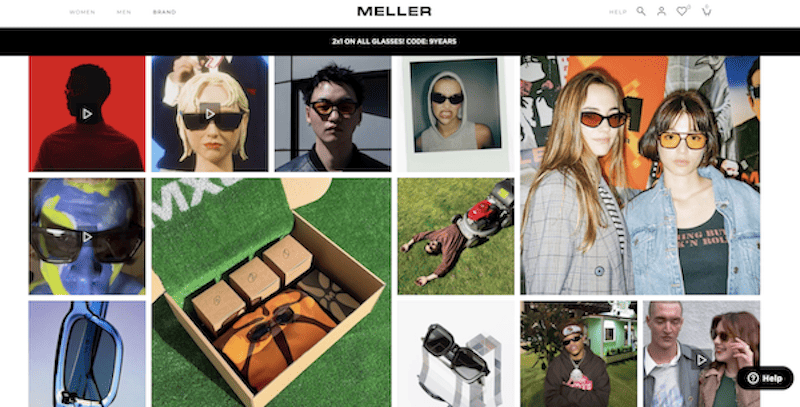
Source: Meller
Integrating UGC into the shopping experience is a smart move. Doing so is proven to increase engagement and conversions.
This is also an example of how your satisfied customers can serve as a sort of content engine for your marketing efforts. Also, this highlights how you can increase the ROI of your influencer campaigns via repurposing.
_4.png?width=800&height=492&name=Meller(1)_4.png)
Source: Meller
Creator content can support your marketing efforts elsewhere. The marketing power of UGC extends so much further than social posts.
Weave it into product pages. Repurpose it in ads. Work it into email funnels.
The possibilities go on and on! What you do with your brand’s creator content is up to you. That said, don’t miss opportunities to boost your marketing elsewhere.
The positive impact of creator content isn’t restricted to digital marketing.
We’ve seen firsthand how Influencers can seamlessly drive in-store sales. Transitioning online brand buzz into real-world action is possible with the right creators.
For example, Health-Ade Kombucha wanted to drive brand awareness and conversions in seven key retailers. The goal was clear: target consumers who already drink kombucha and let them know exactly where to find their product.
Through an influencer marketing campaign with our micro-influencer platform and network, the brand got 30 micro-influencers to post about their brand in a 90-day period. The result was 60,000+ “Likes” and over one million people reached.
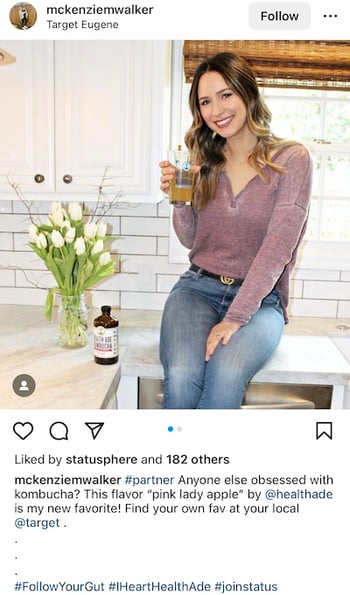
Source: @mckenziemwalker
Smaller creators provide a scalable way to get in front of specific audiences. about your brand, the better. Influencer audience targeting allows brands to get in front of millions of people more reliably and cost-effectively than celebrity posts.
The nature of social algorithms (on both TikTok and Instagram) reinforces this trend. Brands can get so much more mileage out of a batch of micro-influencer posts versus one or two posts from “celebrity” creators.
If you want to learn more about how Health-Ade crushed its micro-influencer campaign with Statusphere, check out our case study.
We’ll bite: choosing between bigger and smaller creators isn’t always a matter of either-or.
Brands can definitely benefit from a combination of both.
In fact, some brands collaborate with a combination of small and large creators. Sometimes the most effective influencer campaigns implement a hybrid strategy.
Even massive brands with millions of followers like Glossier, Target and Sephora repost content from creators with just a few hundred followers. That’s because authentic content is more important than follower count.
Fashion brand Anthropologie collects UGC with their branded hashtag (#UnexpectedAndUnforgettable) and reposts content from creators of all sizes.
Here are some examples of two different creators showing off their summer styles. The creator on the left has only 144 followers, while the one on the right has over 130,000.
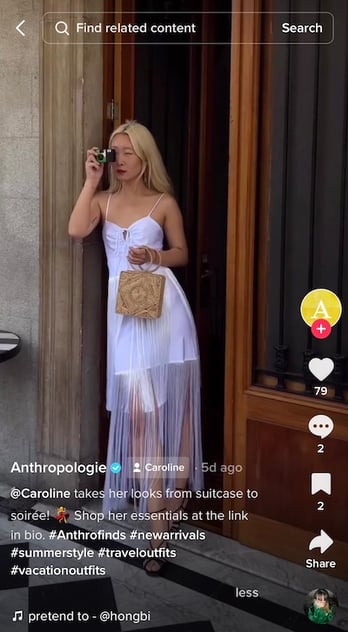
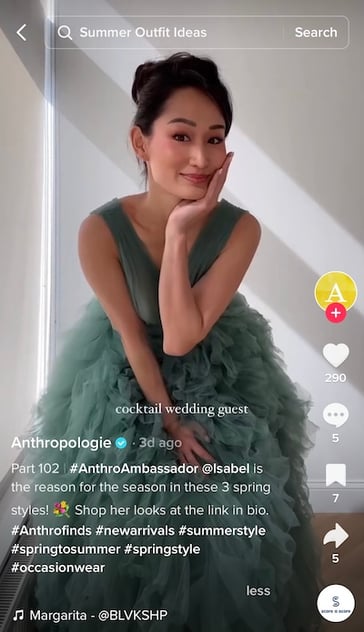
Source: @Anthropologie / @Anthropologie
Even the smallest creators deliver value. 92% of consumers trust recommendations from friends and family versus branded ads. Creators with small enough followings fall into this high-trust category. Again, the top creators and their content resemble that of everyday consumers.
Totally different types of products on TikTok go viral all the time.
From makeup to home goods and gadgets, it's difficult to find an industry that doesn't have some sort of viral product behind it.
Food for thought: there's plenty of attention to go around when it comes to discovering new products. Just because a competitor or a similar product to yours popped off doesn't mean you can't.
Quite the opposite, actually.
Look no further than a brand like Cirkul as a shining example of what we mean. There are dozens of viral water bottle brands across TikTok. That said, Cirkul has managed to stake its claim by partnering with a super high volume of micro-influencers.
The brand's viral water bottle stands out thanks to the countless creators posting authentic content. Cirkul keeps its momentum going strong by consistently sending products to micro-influencers.
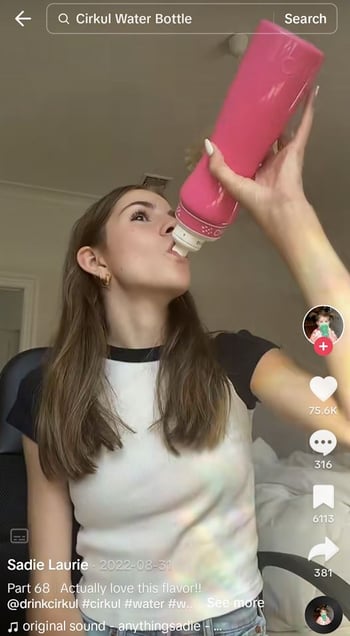
Source: @anythingsadie
The number of views across their various branded hashtags is staggering. This includes over 1.5 billion views on #Cirkul and over 900+ million views on #DrinkCirkul.
This level of engagement and reach simply isn't possible when you're only working with a handful of larger creators. That's the power of an always-on micro-influencer marketing strategy in action!

Source: TikTok
Influencer marketing is a numbers game. The number that matters isn't follower count, though: it's how many creators you can get showing off your product.
Having a high volume of creators hyping your product is always ideal. This is especially for brands that want to scale their social presence.
Each creator posting about you represents an opportunity to trend in the TikTok and Instagram algorithms. Not to mention each piece of UGC has the potential to be repurposed as an ad.
The examples above highlight how brands across industries see results through creator partnerships. To wrap things up, here’s a quick breakdown of what the best influencer campaigns have in common:
Inspired by our influencer marketing examples and ready to dive in?
Awesome! Influencer content is a proven way for brands to consistently show off products, build loyalty and make lasting impressions on potential customers.
The catch, though? Building an influencer campaign and finding micro-influencers involves a ton of moving pieces. This can be especially daunting when you’re juggling multiple marketing channels.
That’s where Statusphere comes in.
Our turn-key micro-influencer marketing platform removes the legwork of running campaigns for brands. From matchmaking and fulfillment to performance tracking and more, our streamlined solution saves brands an average of 100 hours per month.
Want to learn more about how our platform works? Contact one of our consumer-to-consumer marketing experts to see how we can scale your brand's micro-influencer marketing efforts in a fraction of the time.

Adopting an always-on influencer marketing strategy is key to better campaign ROI. This post explains why influencer campaigns shouldn’t be one-hit...
Influencer gifting campaigns can build awareness and help brands get influencer content at scale. Here’s how to send products to influencers with a...
Not sure where you should run your next influencer marketing campaign? Below we explain the benefits of TikTok vs. Instagram to help you choose.
Be the first to know about the latest tools, trends and strategies in influencer marketing for brands.